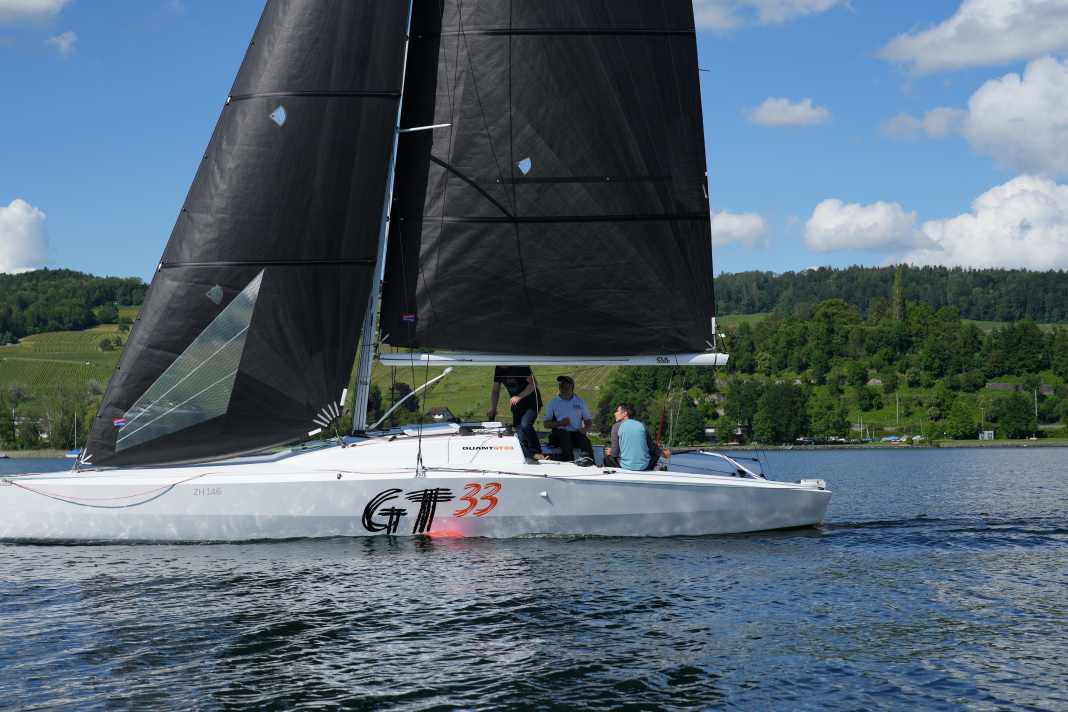





The first boat was built on the island of Cowes in England, made entirely of carbon fibre sandwich with epoxy. The lighter the boat, the greater the efficiency of the DSS foil, which is extended from the side of the hull. DSS is the abbreviation for Dynamic Stability System and is the hobbyhorse of English designer Hugh Welbourne. He was instrumental in developing the system and has already successfully implemented it in numerous new-build projects.
Among other things, Welbourne, together with the Swiss Michi Aeppli from Quant Boats, fitted the Quant 28 test boat with a DSS foil years ago. The system and how it works was presented in detail in YACHT issue 16/2011. DSS is essentially based on an asymmetrical hydrofoil profile that is pushed out of the side of the hull downwind and develops a dynamic force upwards when travelling through the water. The buoyancy on the wing not only increases the righting moment, but also provides lift for the entire system. This means that the faster the boat sails, the greater the resulting upward force. This leads to less immersion depth, which in turn reduces the wetted surface and drag through the water. This means: a higher speed potential, significantly more stability upwind and noticeably faster acceleration.
Improved technology and two versions
With the new Quant GT 33, Welbourne and Aeppli now want to refine the concept and functionality of DSS even further. The flexible foil on the new boat is slightly curved upwards in order to always work efficiently at different heeling angles. The angle at which the wing exits the boat can also be adjusted. The rudder blade will also be fitted with additional foils, so-called elevators. They will be adjustable and ensure optimally balanced sailing characteristics.
Quant builder Michi Aeppli will be offering the new GT 33 in two versions. Version A comes with a reduced ballast content of only 300 kilograms in the deep T-keel, but with water ballast tanks with a capacity of 300 litres each installed on both sides of the boat. This version is ideal for sailors who want to sail longer distances with small crews. Version B, on the other hand, is intended for crews, without water ballast, but with more equalising weight as a lead bomb on the keel weighing 550 kilograms. Incidentally, the tanks for the water ballast are connected below deck with a pipe system. It should take around 35 seconds for the water to change sides completely when the tank is full during manoeuvres.
With a hull length of ten metres, the Quant GT will weigh just over one tonne. With a width of 2.50 metres, the boat can still be easily transported on a trailer on the road without any additional requirements. In addition, the lifting keel with an impressive draught of 2.40 metres can be almost completely raised via a buoy. What's more, the rudder blade is only attached to the stern and can be easily removed.
Technical data Quant GT 33
- Construction: Hugh Welbourne/Quant Boats
- Hull length (without bowsprit): 10,00 m
- Width: 2.50 m
- Draft lifting keel: 1.04-2.40 m
- Weight version A (with water ballast): 1,050 kg
- Weight version B (without water ballast): 1,300 kg
- Ballast version A: 300 kg
- Ballast version B: 550 kg
- Mainsail: 31.7 m²
- Jib: 17.6/14.5 m²
- Code Zero: 48.8 m²
- Gennaker: 79,5 m²
- Motorisation: Outboard motor
